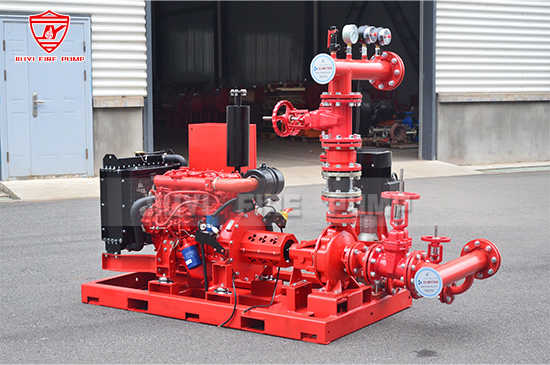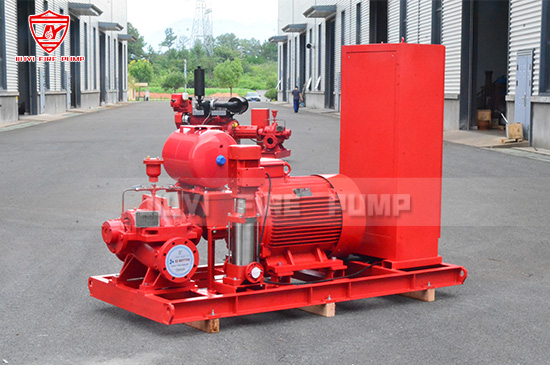Fire pumps play a crucial role in ensuring the safety of lives and property in the event of a fire. As part of a fire protection system, these pumps are responsible for supplying water at a required pressure and flow rate to extinguish fires. To ensure they function as intended, it’s essential to test fire pumps regularly. In this article, we will guide you through the essential steps of testing fire pumps, the types of tests required, and the importance of testing to ensure optimal performance.
Fire pumps must be able to perform reliably when needed the most. Testing ensures that the fire pump delivers adequate water flow and pressure to meet the demands of the fire protection system. Regular testing helps to:
Prevent system failure during emergencies.
Maintain compliance with fire safety codes and standards.
Identify potential issues before they become critical failures.
Ensure proper maintenance and operation.
Testing a fire pump involves a series of steps to ensure its readiness. Depending on the type of fire pump (diesel, electric, jockey pump, etc.), the testing procedure may vary slightly. However, the core principles of testing remain the same.

Visual Inspection
The first step in testing a fire pump is to conduct a thorough visual inspection. This ensures that all components are in good condition and free of obstructions. The following aspects should be checked:
The pump and motor should be clean and free of any debris.
The water supply lines should be properly connected with no visible leaks.
The pump valves should be functional and in the correct positions (open for testing).
The pressure relief valve and other safety components should be in working order.
Test the Pump’s Flow Rate
One of the most important tests for any fire pump is checking the water flow rate. To ensure the pump is working as expected, perform a flow test:
Open the test valve on the discharge side of the pump.
Measure the flow rate using a flow meter. Ensure the pump delivers the rated flow at the required pressure.
The flow rate should meet or exceed the design specifications. If it doesn't, it could indicate that the pump is malfunctioning or requires maintenance.
Pressure Test
After checking the flow rate, the next critical step is the pressure test. The fire pump needs to generate adequate pressure to fight fires effectively. Here’s how to conduct a pressure test:
Attach a pressure gauge to the discharge pipe.
Run the pump and observe the gauge to check the pressure.
Ensure that the pressure meets the manufacturer's specifications for both the rated and operational conditions.
If the pressure falls below the required levels, this could indicate issues with the pump, motor, or piping system.
Diesel Fire Pump Test (if applicable)
For diesel-powered fire pumps, it's essential to check not only the pump's performance but also the diesel engine. Follow these steps:
Test the battery voltage to ensure it can start the engine reliably.
Run the diesel engine under load to ensure it performs correctly.
Check fuel levels and ensure the fuel system is free from contaminants.
Perform a full operational test of the diesel engine and pump unit.
Electric Fire Pump Test (if applicable)
Electric fire pumps are powered by electricity, so ensuring the electrical supply is stable is crucial. Here’s how to test an electric fire pump:
Verify the electrical power supply to the pump.
Check for proper motor operation during the test, ensuring there is no excessive vibration or unusual noises.
Ensure the electric motor runs within the specified voltage and amperage range.
Test the automatic start/stop functionality of the motor.
Check the wiring and ensure no overheating or loose connections.
Jockey Pump Test
Jockey pumps are typically small pumps that maintain pressure in the fire protection system and prevent false alarms. These pumps should be tested periodically to ensure they are in working order. Here's how:
Activate the jockey pump and observe its operation.
Check for proper operation and pressure settings.
Test the automatic start/stop function to confirm it operates when the pressure drops.

System Monitoring
During testing, ensure the system monitoring devices are functioning correctly. These devices, such as pressure and flow sensors, play a vital role in monitoring the system's health and providing early warnings of potential issues. Check that:
The fire pump control panel displays correct information.
Alarms are functioning as expected.
The monitoring system communicates properly with other components in the fire safety network.
Test for Compliance with Standards
Fire pumps must comply with various standards, such as those set by the National Fire Protection Association (NFPA), Underwriters Laboratories (UL), or FM Global. After completing the functional tests, verify that the fire pump meets these standards:
Review the pump’s specifications and certifications to ensure it is compliant with applicable codes.
Ensure the fire pump is performing in accordance with the flow and pressure requirements outlined in NFPA 20 or the local building codes.
Document the Test Results
Proper documentation is essential for tracking the fire pump’s performance over time and ensuring compliance with regulations. After conducting the tests, record the results in a maintenance log, including:
Date and time of the test.
Test parameters such as flow rate, pressure, and operational conditions.
Any issues discovered during testing, such as leaks or performance deficiencies.
The actions taken to address these issues.

While testing your fire pump, you may encounter some issues. Here are some common problems and how to address them:
Low Flow or Pressure
If the pump is not delivering the required flow or pressure, check for clogged filters or pipes, and ensure the pump is correctly sized for the system.
Motor Failure
If the pump motor does not start, ensure the power supply is stable. For electric pumps, check the wiring, fuses, and circuit breakers. For diesel pumps, ensure the engine has enough fuel and a charged battery.
Leaks
Leaks can cause a loss of pressure and reduce the pump’s efficiency. Inspect all connections, gaskets, and seals to identify and replace any faulty components.
To maintain the pump’s effectiveness, regular testing is essential. The National Fire Protection Association (NFPA) recommends the following testing intervals:
Weekly: Perform a short test of the pump’s automatic start function and verify that the pressure is within operational limits.
Monthly: Conduct a full system test, including flow and pressure checks.
Annually: Perform a comprehensive inspection and test of the fire pump, including a performance test and inspection of mechanical components.
Testing fire pumps is a vital part of maintaining a functional and reliable fire protection system. By following the proper testing procedures, you can ensure your fire pump is in top condition, ready to provide reliable protection when an emergency strikes. Regular testing also helps identify potential issues early, saving time and costs related to repairs and maintenance.
By adhering to industry standards and keeping detailed records of your testing procedures, you ensure compliance with fire safety regulations and maximize the efficiency of your fire pump system. Regular testing provides peace of mind knowing your fire pump is always ready to perform its critical role.